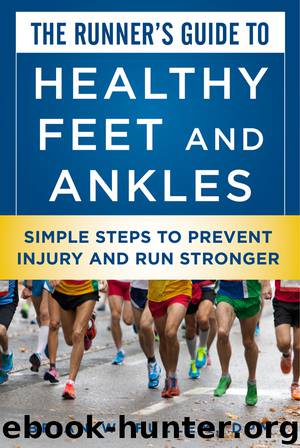The Runner's Guide to Healthy Feet and Ankles by Brian W. Fullem

Author:Brian W. Fullem
Language: eng
Format: epub
Publisher: Skyhorse Publishing
Published: 2016-08-22T16:00:00+00:00
Final Thought
An injured tendon can develop into a more chronic and difficult injury than most other injuries, including fractures. If swelling is noted and at-home remedies of ice and rest don’t help enough, then seek treatment from your local sports podiatrist. As with most injuries, the sooner it is treated, the faster you can return to running.
Chapter Five
Stress Fractures
Treating stress fractures in athletes can be challenging. Runners who participate in school, professionally, or at the highest local levels often have a narrow time frame to train and compete in their desired sporting activities. Reducing healing time by every means possible is crucial to the success of these athletes. For some, running is their main form of exercise and stress relief, so returning to training can be just as important to the recreational runner. The goal of any sports medicine professional should always be to return the athlete back to activity as soon as is safely possible for the athlete.
Stress fractures were first described in 1855 as “march fractures” by the Prussian military surgeon Breithaupt, who made the clinical description of swelling and pain in feet with a metatarsal stress fracture. The fractures were closely associated with the marching done by soldiers. In 1897, with the advent of X-rays, it was possible to see stress fractures in military recruits forced to go on long marches, thereby establishing the association between stress fractures and overuse. In modern times, many competitive athletes will straddle the fine line between optimal fitness and injury to achieve the best performance possible, making them susceptible to this injury.
In 1987, a landmark paper by Dr. Gordon Matheson, the former chief of sports medicine at Stanford University, analyzed stress fractures (as verified via bone scans) in 320 athletes from a variety of sports, of which 221 were runners with an average weekly mileage between twenty-seven and forty-four miles. He assessed the results of conservative management. The most common bone injured was the tibia (49.1 percent), followed by the tarsals (25.3 percent), metatarsals (8.8 percent), femur (7.2 percent), fibula (6.6 percent), pelvis (1.6 percent), sesamoids (0.9 percent), and spine (0.6 percent). Stress fractures were on both sides (bilateral) in 16.6 percent of cases.
Download
This site does not store any files on its server. We only index and link to content provided by other sites. Please contact the content providers to delete copyright contents if any and email us, we'll remove relevant links or contents immediately.
Periodization Training for Sports by Tudor Bompa(8211)
Bodyweight Strength Training by Jay Cardiello(7878)
Born to Run: by Christopher McDougall(7090)
Inner Engineering: A Yogi's Guide to Joy by Sadhguru(6752)
Asking the Right Questions: A Guide to Critical Thinking by M. Neil Browne & Stuart M. Keeley(5708)
The Fat Loss Plan by Joe Wicks(4876)
Bodyweight Strength Training Anatomy by Bret Contreras(4645)
Yoga Anatomy by Kaminoff Leslie(4333)
Dynamic Alignment Through Imagery by Eric Franklin(4177)
Science and Development of Muscle Hypertrophy by Brad Schoenfeld(4103)
Exercise Technique Manual for Resistance Training by National Strength & Conditioning Association(4021)
ACSM's Complete Guide to Fitness & Health by ACSM(4019)
The Four-Pack Revolution by Chael Sonnen & Ryan Parsons(3945)
Bodyweight Strength Training: 12 Weeks to Build Muscle and Burn Fat by Jay Cardiello(3940)
The Ultimate Bodybuilding Cookbook by Kendall Lou Schmidt(3906)
Yoga Anatomy by Leslie Kaminoff & Amy Matthews(3880)
American Kingpin by Nick Bilton(3819)
Nutrition for Sport, Exercise, and Health by Spano Marie & Kruskall Laura & Thomas D. Travis(3742)
Yoga Therapy by Mark Stephens(3721)
